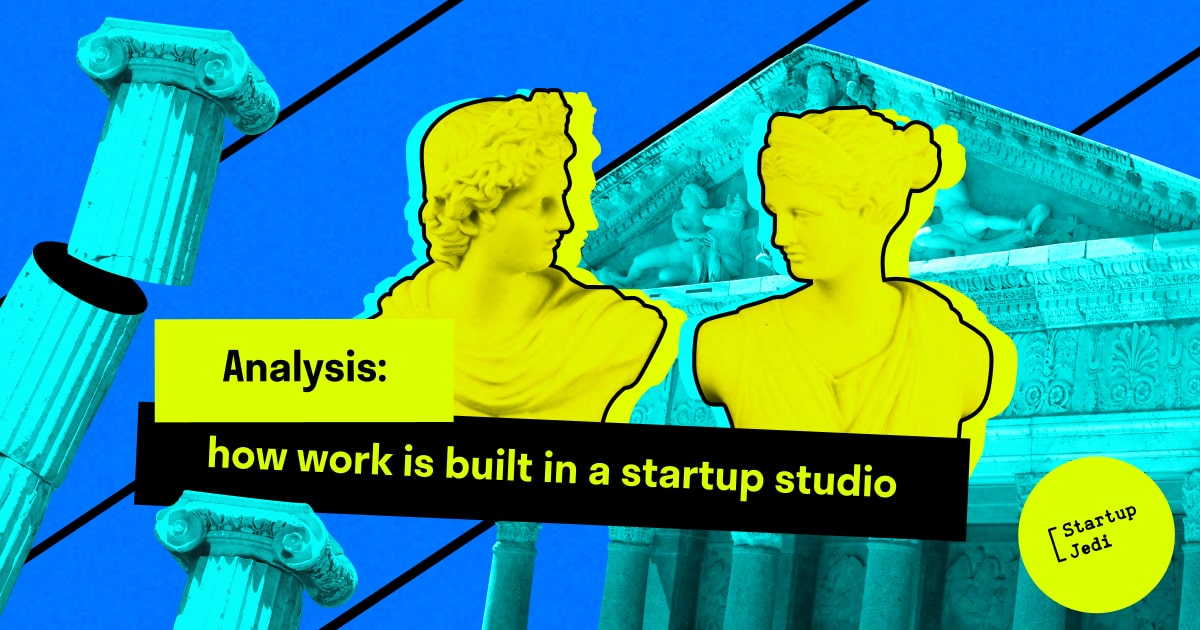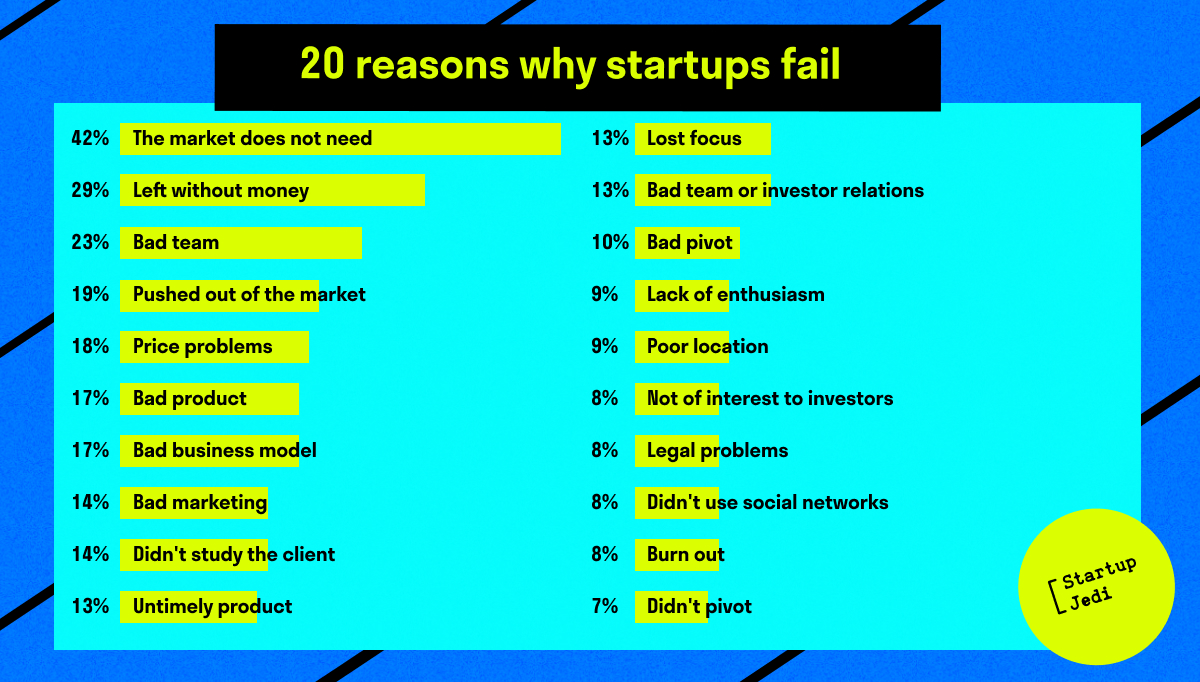
Startup Jedi
We talk to startups and investors, you get the value.
The best way to learn how a VC studio works is to observe their work from the inside.

Startup Jedi
We talk to startups and investors, you get the value.
The best way to learn how a VC studio works is to observe their work from the inside. But if you’re not ready to start an internship at one of the startup studios any time soon, let’s make it easy for you and tell you everything here.
Unlike accelerators and incubators, which accompany a startup at a certain point in time, the startup studio is responsible for the whole process: from the conception of an idea to the emergence of a prospective company on the IPO, because the studio is not a mediator but a full-fledged founder of each project. Consider each workshop in the startup factory in order!

Most start-up studios work only with their own ideas. The team of founders in the studio replaces the team of product managers: they are employees of the studio, receive a salary, work on a permanent basis, but most often also get a share in the project.
How does the studio select such managers? Certainly, it is not just a middle or senior specialist from the HeadHunter platform that is needed — he should have extensive working experience with startups (both negative and positive). More likely, a product manager in a startup studio is a serial entrepreneur. As a rule, such specialists are either initially in the team, or are looking for acquaintances, or undergo a long thorough selection and “battle check”.
How do you build a work if a studio does cooperate with an outside entrepreneur? Then, in the first stage, all agreements and areas of responsibility are formed. The process is always individual, but in any case the studio is included in the project on the rights of the cofactor, which will close off part of the functions on starting up. As a rule, the founder switches entirely to work with the product, and the studio becomes analogous to the CEO and provides all the infrastructure: finds specialists in the team, organizes the sales office, and communicates with investors.

Perhaps one of the main tasks of the studio is to organize the process of working with ideas. Everything must be automated: the best ideas must be collected, examined first and sent to the next stage. In simple terms, you have to build a pipeline of ideas!
These techniques are mainly used in various combinations to find ideas:
The work of an analyst who studies a certain market, collects trends, ideas and interesting projects.
Interviewing external experts.
Brainstorming sessions of the studio team.
An order from corporate clients (large technology companies) for the production of a certain technology.
An order from venture investors.
Ideas from the studio's top management.
Research and invitation to cooperation of startup teams with an idea at a very early stage of development.
Prosperous startups do not attempt to capture the entire market, but operate within a niche where they have expertise, contacts and resources. One of the world’s largest startup studios — German Rocket Internet — works mainly in the markets of food technology, travel, fashion technology. Studio M13 from the United States selected the markets for finance, transportation services, and SaaS.
As a rule, at this stage ideas go through the first, roughest and fastest scoring (evaluation system). The criteria are the simplest: possibility to get a profit, realism, conformity to the direction of work of the studio. Then all suitable ideas go to the next stage of the pipeline.

At this stage, the main competitive advantage of startup studios — speed — enters the game. While the startup team is testing a single idea, the studio is checking dozens. That’s why it’s so crucial to have the fastest and most efficient process of checking ideas, giving the team all the resources to do it. The product manager considers business models, analyzes the market, considers the unit economy, studies search questions, similar projects and interviews experts.
So 20-30 ideas can be worked out in a month, then the results are presented to the studio management: they choose 2-3 ideas with which the team will work further.

At this stage, ideas are eliminated from most of the risks that startups kill in the early stages: the nonprofit of the idea, the absence of a unit economy, the uselessness to the market and the user.

Then, the product manager of the studio works with the creation of the prototype and testing of MVP. Sometimes, if the idea is tested in a complex market, a person from the market is invited as a product: he receives not only a salary, but also a share in the project.
This stage determines the future of the idea. The product tests it on a potential audience, creates a prototype and if it is successful receives the first sales. At this stage, the initial startup team is formed.To speed up the work, the studio provides a back office to help the product manager: sales specialists, lawyers, designers, marketers, consultants.
The golden rule of testing MVP in startup studios is to involve the development department as soon as possible: ideas are tested by “manual” method, and IT-specialists start working with already tested prototypes at the next stage.
What part of the idea converts to startups that go to the Pre-seed stage? No exact formula, of course, but the statistics of the Russian startup studio Admitad Pro is the following: Since 2019, the studio team has tested about 150 business ideas, from which they have made several projects at the stage of pre-seed. The Seed Round reached 9 projects, up to Round A — 4. That is 6% of the ideas reached the first investment.
At this stage, the factory has the highest mortality rate of projects: if a startup "survives" to the Seed round, it most likely survives. But even the very opportunity to test 150-200 ideas in a couple of years is impressive.

After the startup team (now we can exactly call it that) manually checked the hypothesis and got the first sales, everything remains to be automated. Here the developers and the sales department of the studio join the project.
The project, which proved the need of the idea and made the first sales, received a Seed investment. As a rule, in the studios the decision to move to the Seed stage is made by a special investment committee, which includes studio executives, studio investors, and outside experts.
The amount of investment at this stage can be between $50,000 and $2 million. Sometimes studios finance startups from their own funds, but most attract external investors already in the seed investment phase.

This is the longest stage in terms of time: here a startup from a proven prototype will have to become a mature company. On average, startups need about 2 years to reach the next round of financing.
In some studios at this stage an external entrepreneur is engaged as a CEO project. Depending on the priority of the project, the management of the studio decides on the extent to which it will invest further resources in the project: the distribution of shares depends on this. Typically, the founder’s contract provides the opportunity to increase the share as the company grows, giving additional motivation.
The sales department of the startup studio helps to achieve sustainable sales of the company. This tool allows to give a serious head start to single entrepreneurs: the startup team is only required to give a presentation about the product, then sales specialists independently pack the product, produce promotional materials, make a presentation, build a media plan, etcetera. In addition, sellers already have their own developed database of LPP (decision makers) in large companies (especially valuable for b2b projects), sometimes several startups sell packets.

If the project shows good growth and profitability, one day the time comes for the next round of investment. Startups raised in a venture capital studio in the United States raise an average of $2.47M 12 months after leaving the studio.
As soon as a studio startup starts to grow in the market, it works to get out — it’s an acquisition, a merger, or a sale. This is how the project absorbs all the costs of its creation and brings profit to the studio.
Is it possible to get this profit? Let's turn to the Crunchbase data:
The American startup studio M13 attracted 162 times more investor funds to its projects than it invested itself. 10 projects of the studio were sold (or entered into mergers and acquisitions).
IONIQ projects raised 128 times more funds than were invested.
Rocket Internet, which we have already mentioned, received $3.9B for the studio itself and $15.5 billion for portfolio companies.
Flagship Pioneering sold/ brought to the IPO 61 companies.
The numbers are true: the pipeline approach to startups really works!
Our tour of the startup factory is complete. Today’s startup, which we followed from the very beginning of the idea, is a lucky one: it managed to get to the last stage of the pipeline operation. His brothers and sisters are less fortunate: we remember that conversion from ideas to seed projects is 6—7% for operating studios. And yet this is a huge result: because, based on the same statistics, of the 100 entrepreneurs who planned to set up a startup, 94 will have no results, spending time and resources.
Organizing and setting up a whole pipeline for the production of startups is a much more complicated task than creating a single startup. But, as we can see, well-structured work pays off all efforts. Welcome to the startup factory!
Facebook: facebook.com/StartupJedi/
Telegram: t.me/Startup_Jedi
Twitter: twitter.com/startup_jedi
Comments